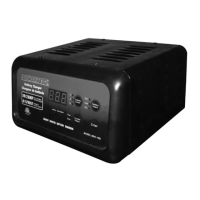6
TROUBLESHOOTING / WARNING / GUARANTEE
Troubleshooting:
Fault Possible cause Solution
No charging current Bad contact of power socket
Repair or change power
socket.
Initial voltage is too low. Change battery.
+ and - polarity terminals of battery are
oxidized and/or dirty.
Clean terminals.
Battery has been damaged. Replace battery.
Low charging current
+ and - polarity terminals of battery are
oxidized and/or dirty.
Clean terminals.
Battery not accepting charge Replace battery.
Battery is charged fully. Measure specific gravity
Excessive transformer
noise
Unstable position
Change position for
proper placement
WARNING:
1. Before use, carefully read the instruction manual and retain for future reference.
2. The chargemaster charger is not weather proof. So care and common sense must
be exercised if using outdoors. Do not expose to moisture.
3. Always switch off power at the mains supply before connecting or disconnecting
the battery charger & engine starter.
4. Never smoke, cause a spark or charge near an open flame. Never allow conduc-
tive materials to short circuit the charger or battery terminals.
5. Always use in a well-ventilated space.
6. This appliance is not intended for use by young children or infirm persons without
supervision and should always be used responsibly and stored in an appropriate
place to prevent misuse.
7. If the mains lead is damaged, it must be replaced by the manufacturer, an author-
ized service agent or a suitably qualified person in order to avoid any potential haz-
ards.
Guarantee:
This sip battery charger is covered by a 12 month parts and labour warranty covering
failure due to manufacturers defects. This does not cover failure due to misuse or op-
erating the machine outside the scope of this manual.
In the unlikely event of warranty claims, contact your distributor immediately. Proof of
purchase will be required before any warranty can be honoured.
3
SAFETY INSTRUCTIONS
Safety Instructions:
1. This Instruction Manual contains important safety instructions. Please keep it safe
for future reference.
2. The Chargemaster smart 16 battery charger is designed to charge 6v &12v Stan-
dard lead acid, AGM and Gel lead-acid batteries as shown in Table 1. Do not
attempt to charge batteries of other types.
3. The charger is designed to be powered from a domestic mains power outlet,
which is reliably connected to the buildings ground (earth) point. If the supply ca-
ble needs to be extended, ensure the cross-sectional area of the wire is of a suffi-
cient size for the supply of current over the distance required.
4. If the charger is interrupted or damaged due to heavy impact etc., the battery
should be taken off charge immediately.
5. Do not dismantle the charger. If repairs are required, they should be performed
by a suitably qualified person. Incorrect reassembly may result in a fire hazard
and / or electric shock. Always disconnect the charger from any connected bat-
tery and the mains supply prior to cleaning the casing.
6. When connecting the charger to a vehicle’s battery. Always connect the battery
terminal not connected to the chassis first. The other connection is to be made to
the chassis as far away as practical from the battery and fuel line (a spark can be
generated when connecting the second clip which can ignite battery or fuel
gases). The battery charger is then to be connected to the mains supply. Once
charging is complete, disconnect the battery charger from mains supply first, and
then remove the chassis connection followed by the battery connection.
7. During charging, batteries give off some hydrogen and oxygen creating a highly
explosive mix. Ensure adequate ventilation exists and avoid sparks, smoking,
etc…
8. During battery maintenance ensure adequate clean water is available in the
event of an acid spill. The liquid inside batteries is highly corrosive therefore ensure
that it is not allowed to make contact with the skin (especially eyes). In the event
of contact, flush the area with clean water and immediately consult a doctor.
9. Lead-acid batteries store a large amount of energy. Short-circuiting the battery or
charger terminals will cause the battery to try and release this energy immedi-
ately, which can result in fire or personal injury. Prevent any metal object (or other
conductive material) from touching the + and – terminals of the charger or bat-
tery at the same time.

